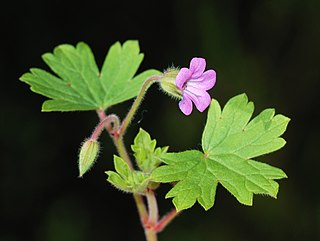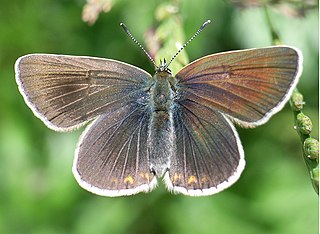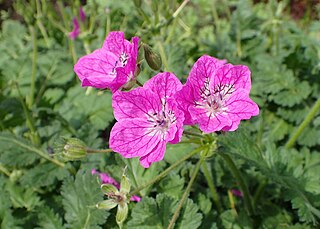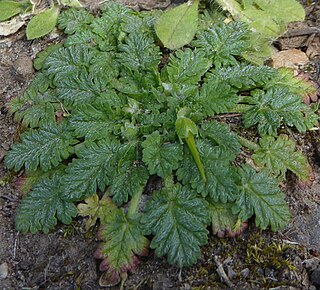
Geranium is a genus of 422 species of annual, biennial, and perennial plants that are commonly known as geraniums or cranesbills. They are found throughout the temperate regions of the world and the mountains of the tropics, with the greatest diversity in the eastern part of the Mediterranean region.

Geraniales is a small order of flowering plants, included within the rosid subclade of eudicots. The largest family in the order is Geraniaceae with over 800 species. In addition, the order includes the smaller Francoaceae with about 40 species. Most Geraniales are herbaceous, but there are also shrubs and small trees.

Geraniaceae is a family of flowering plants placed in the order Geraniales. The family name is derived from the genus Geranium. The family includes both the genus Geranium and the garden plants called geraniums, which modern botany classifies as genus Pelargonium, along with other related genera.

Erodium is a genus of flowering plants in the botanical family Geraniaceae. The genus includes about 60 species, native to North Africa, Indomalaya, the Middle East, and Australia. They are perennials, annuals, or subshrubs, with five-petalled flowers in shades of white, pink, and purple, that strongly resemble the better-known Geranium (cranesbill). Cultivated plants are known as filarees or heron's bill in North America, whereas in the British Isles they are usually called storksbills.

Erodium cicutarium, also known as common stork's-bill, redstem filaree, redstem stork's bill or pinweed, is a herbaceous annual – or in warm climates, biennial – member of the family Geraniaceae of flowering plants. It is native to Macaronesia, temperate Eurasia and north and northeast Africa, and was introduced to North America in the eighteenth century, where it has since become naturalized, particularly of the deserts and arid grasslands of the southwestern United States.

Eumedonia eumedon, the geranium argus, is a butterfly of the family Lycaenidae. It is found in the Palearctic realm. This butterfly has been included in the genera Plebejus, Plebeius, Polyommatus and Aricia, but recent molecular studies have demonstrated that Eumedonia is a valid genus, different from the previous genera mentioned.

California macrophylla, commonly known as roundleaf stork's bill, is a species of flowering plant in the geranium family, Geraniaceae. It was formerly placed in the genus Erodium, but was later placed in a monotypic genus of its own named California.
Common stork's-bill is a common name for several plants and may refer to:

Erodium acaule is a species of plant in the family Geraniaceae.
Erodium astragaloides is a species of flowering plant in the geranium family Geraniaceae. It is endemic to Sierra Nevada, southern Spain.

Roger Charles Carolin is a botanist, pteridologist and formerly an associate professor at Sydney University. He was appointed as a lecturer in botany at the University of Sydney in 1955 earned a Ph.D from Sydney University in 1962 with a thesis on the floral morphology of the campanales, and retired as an associate professor in 1989.

Erodium manescavi, called the garden stork's-bill, large purple storksbill, Manescau storksbill, Manescau heronsbill and showy heron's bill, is a species of flowering plant in the family Geraniaceae. It is native to the Pyrenees mountains of France, and has been introduced to Austria. As Erodium manescavii it has gained the Royal Horticultural Society's Award of Garden Merit.
Erodium sosnowskianum, or Sosonovskiy's heron's-bill, is a herbaceous plant, a species of the genus Erodium of the family Geraniaceae.
Erodium alnifolium is a species of annual herb in the family Geraniaceae. They have a self-supporting growth form.

Erodium chium is a species of flowering plant in the family Geraniaceae.

Erodium ciconium, the common stork's bill, is a species of annual herb in the family Geraniaceae. They have a self-supporting growth form and simple, broad leaves. Individuals can grow to 21 cm tall.
Erodium laciniatum is a species of flowering plant in the family Geraniaceae.

Erodium chrysanthum, the yellow heron's bill, is a species of flowering plant in the family Geraniaceae, native to central and southern Greece. The flowers are a pale yellow, or rarely a pale pink. A dioecious perennial, it cultivation it is hardy in USDA zones 6 through 8, and is recommended for rock gardens, trough gardens, and borders.

Erodium maritimum, the sea stork's-bill, is a herbaceous perennial plant in the family Geraniaceae. It occurs on free-draining stony soils close to the sea and, very occasionally, in similar situations inland. Most of the world's population occurs in southern Britain and Brittany, but it is found in scattered locations around the coast of Europe as far as Corsica and Italy, and south to the Canary Isles.












